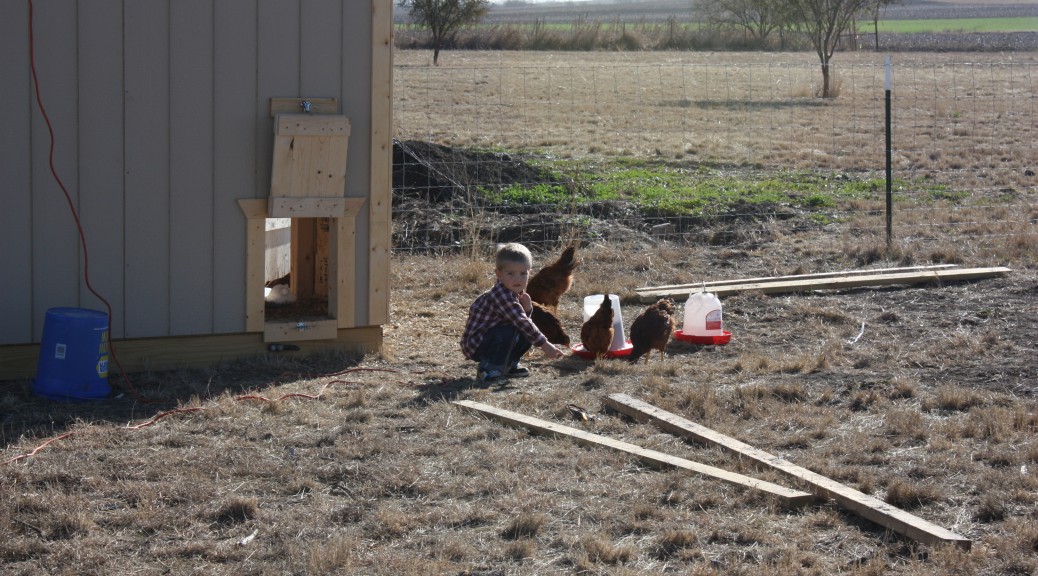
I had thought I had taken pictures of the chicken coop while I was building it. True to form, I got busy and forgot. So… I guess you get to settle with a picture of Michael doin’ what he spends a lot of time doing: Playing with chickens.
Liz decided she wanted a lot of fresh eggs, which translated into an order of 40 chicks (straight run, so about half would end up in the stew pot as young roosters). The only problem is that you can’t use a standard back-yard chicken coop for those kinds of numbers. To make things worse, Liz and the kids have grand plans to get even more chicks and sell eggs since babysitting gigs are hard to come by when there aren’t many neighbors. I settled on a 8X12 shed framed on 24″ centers with a simple corrugated steel roof. My thought at the time was that if the chickens didn’t work out, I’d still have a usable shed.
Liz originally had grand plans of moving the chicken coop around the yard to spread the manure and lighten the wear and tear on the “lawn,” so I built it on “skids” with the hope I could drag it around with the tractor. The only problem I had with that plan, is that the completed coop weighed so much it acted like a road-grater as I pulled it to it’s final resting spot. In the end I decided we would just have a “chicken yard” for the birds, and leave the coop where it was.
I made the roosts by cutting the corners off of 5 2×2 firring strips with the table saw blade set for 45 degree angle and setting them into 2 2x4x8s notched about every 18 inches, essentially making an 8 foot wide ladder and leaning it up against the wall at about a 45 degree angle.
In one corner of the coop I built a 2’x6′ “isolation room” that we could use as a brooder, and in another I built a bank of 12 1 cubic-foot nest boxes. Given the way the birds willingly cram onto the roosts, and the internet-derived recommendations for nest boxes and roosts, we should be able to support up to about 45 layers.
The last thing we did was run power out to the coop so we could plug heat-lamps in when it got cold or when we had chicks in the brooder. That turned out to be almost as expensive as building the coop, but well worth it in the end.
One thing I learned a long time ago is that if you are going to dig a trench and put in conduit, cram as much into the trench as you can afford so you don’t have to dig it again. Since I had to run pipe as it was, I decided to run 2-20A circuits (one for the coop, and one for a future small barn/animal shed) and pull water out to the corner of the chicken yard so we wouldn’t have to drag buckets from the house when it was below freezing outside.  It’s turned out to be a real blessing to have the freeze-proof hydrant in the chicken yard, and we’ve already used the heat-lamps since Liz and a friend decided to split an order of cornish-rock meat chickens and we had to have a place to put them. The water and electricity will come in handy when we get the barn built too.
It’s turned out to be a real blessing to have the freeze-proof hydrant in the chicken yard, and we’ve already used the heat-lamps since Liz and a friend decided to split an order of cornish-rock meat chickens and we had to have a place to put them. The water and electricity will come in handy when we get the barn built too.
